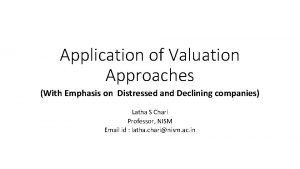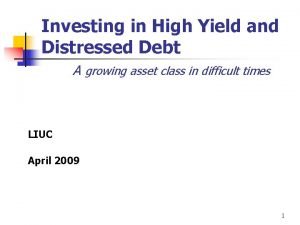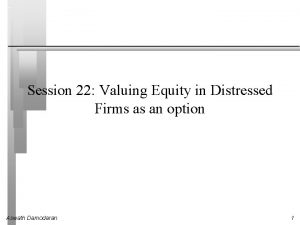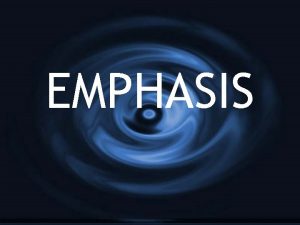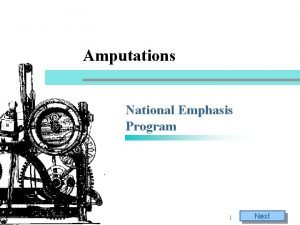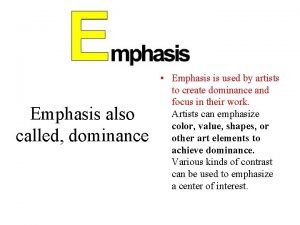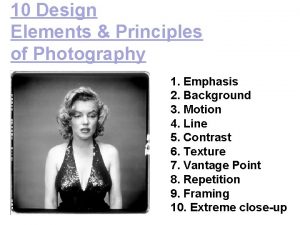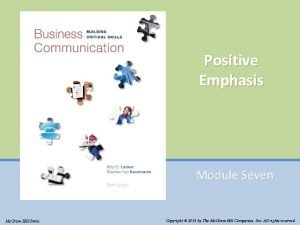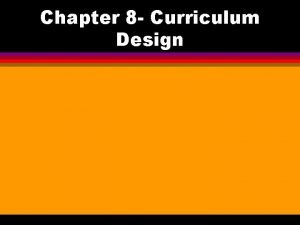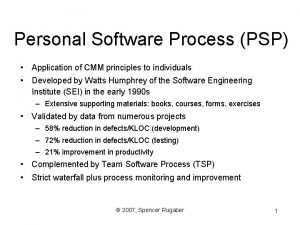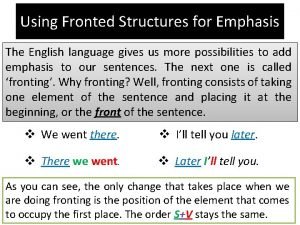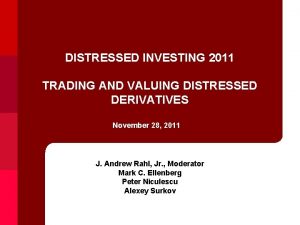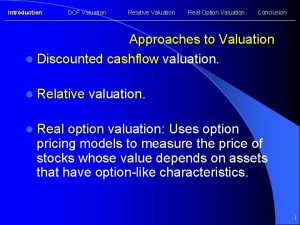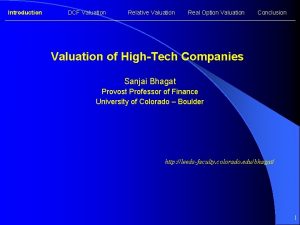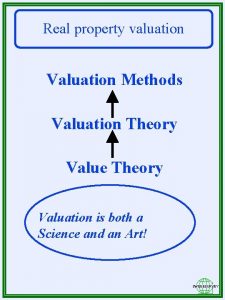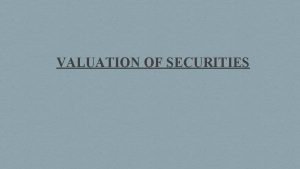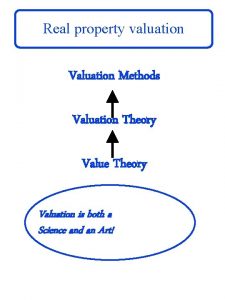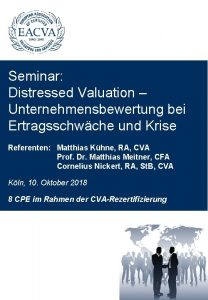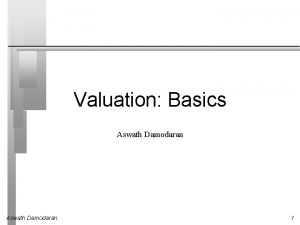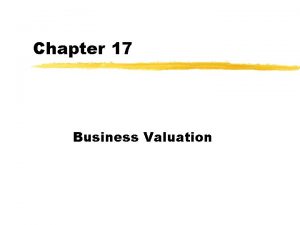Application of Valuation Approaches With Emphasis on Distressed






















- Slides: 22

Application of Valuation Approaches (With Emphasis on Distressed and Declining companies) Latha S Chari Professor, NISM Email id : latha. chari@nism. ac. in

Agenda • Basic concepts related to valuation • Sources of value – Valuation methods and approaches • Tying up Balance sheet with Enterprise value • Excel examples of general case valuation and check your understanding questions • Company life cycle and valuation tussle • Characteristics of distressed companies • Challenges to valuation of distressed companies

Basic concepts • Price Vs. Value • Market value Vs. Book Value • Trading value Vs. Transaction Value • Value of the firm Vs. Value of equity Value of the operational business i. e Enterprise Value - Value of debt (less cash) ie Bondholder value = Value of Equity (Shareholder value) Enterprise value is the market value of net operational assets which must equal the market value of net funding THUS : EV = Market value of Equity + Market value of Debt - Cash

Sources of value - Valuation models Sources of Value – Revenue, Earnings, Assets, Intangibles We will look at the following approaches to valuing common shares • Net Asset value method – (Assets) • Dividend Discount Models (Net Earnings to shareholders) • Free Cash Flow Valuation (DCF) - (Earnings) • Comparable Valuation Ratios (Multiples Valuation) – (All)

Approaches to Valuation Income Approach -- DDM, DCF, Earnings capitalization method Market Approach – Relative valuation, Price multiples, Value multiples Cost Approach – Book value, Replacement value, Liquidation of “Assets” value

Enterprise value Vs. Balance sheet Financial Investments, Invt in associates, JV and other financial securities Eg: Land banks • Cash + • Cash equivalents + • Non controlled Investments + • Non-core assets + • Enterprise value (net operating assets) - • Debt (MV) • Preference Shares • Minority interest (MV – PE) n = Ordinary Equity value

Multiple based method • Based on linking VALUE with its VALUE DRIVERS ie earnings with value Value drivers Interest income EBITDA Revenue Cash Debt Equity Enterprise value Valuation Interest expense Net income

Excel Examples • Dividend Discount models • Discounted Cash flow models • Price multiplier model • Comparable company models

Critique of the models • DDM – Zero dividend paying companies, tends to undervalue companies in growth stage – as they may retain more and pay less dividends. • DCF – Highly sensitive to capital cost and growth rates. Cash flow estimates are difficult to predict in the long run. Model assumptions – perpetuity and steady state – Does not match with what the CEO’s would like to do. • Relative valuation – based on fundamentals – tends to overvalue during booms and undervalue during bursts • Relative valuation – based on comparables – difficult to find comparable companies in practice, circular referencing issue

Check your understanding • The Gorden growth model can be used to valuue dividend paying companies that are: a. Expected to grow very fast b. In a mature phase of growth c. Very sensitive to business cycles ANS - b

Check your understanding The primary difference between PE multiple based on fundamentals and PE based on comparables is that fundamental based PE takes into account: a. Future expectations b. The law of one price c. Historical information ANS - a

Check your understanding Asset based valuation methods are best suitable for companies where the capital structure does not have a high proportion of : a. Debt b. Intangible assets c. Current assets and liabilities ANS - b

Check your understanding Which of the following is most likely weakness of present value models? a. Present value models cannot be used for companies that do not pay dividends b. Small changes in model assumptions and inputs can result in large changes in computed intrinsic value c. The value of security depends on the investor holding period and comparing valuations for different investors with different holding periods is difficult ANS - b

Check your understanding Analyst has determined that the appropriate EV/EBITDA for Jaiprakash industries is 10. 2. The following are the forecasted numbers for company: EBITDA – 22000000 Market value of debt – 56000000 Cash – 1500000 Value of Jaiprakash industries is closest to : a. 169 million b. 224 million c. 281 million ANS - a

Company life cycle Vs. Valuation • Early stage companies – Cost and revenue structure not established, may not survive and grow into mature companies • Growth stage companies – estimating growth rates, building for inorganic growth • Mature companies – Relatively easier as they are more stable w. r. t. Revenue, cost structure, capital required • Declining companies or distressed companies – Valuation methods assume going concern and ignore the likelihood of liquidation/distress. DCF and Relative valuation or comparable valuations methods all suffer from this. All valuers are generally optimistic

Difference between Mature stage and Declining stage Mature stage Balance sheet Assets in place - Contribute to total value Growth assets – Minimum/No value Liabilities - adequate leverage - able to service debt Revenue - growth rate falling Declining stage All value/ divestment Negative value More leveraged falling coverage ratios Revenue falling

Common Characteristics of declining companies • Falling revenue and inability to reverse the fall in revenue over considerable period of time, generally accompanied by sector not doing well • Fall in margins or negative margins – lose pricing power and keep reducing price to maintain overall revenue resulting in lower margins • Asset sale – as assets are worth more if sold rather than use • Financial leverage – negative impact. Cost of borrowing > ROCE. Unable to refinance the debt since lenders will demand more stringent terms.

Valuation challenges – implications to DCF • Assets earn less than cost of capital – value destroying preposition • Impact of asset sale/divestiture – impact on revenue and profits is hard to determine. Proceeds of asset sale may show better value in the short run • New capex to earn less than the cost of capital thereby eroding value. Reinvestment also erodes value. • Cost of capital calculation – Affected by huge dividends/buybacks. If debt is also not proportionately reduced, then cost of debt and equity are both affected as leverage ratio increase. Tax advantage of debt disappears when EBIT < Interest. Consequently cost of equity should also increase but the historical betas will reflect changes in equity risk on lagged basis and hence cost of equity may be < Cost of debt (pretax)

Valuation challenges – implications to DCF (2) Terminal value calculation – The company may not function as a going concern. May go into liquidation which is hard to reflect in terminal value of the firm Growth rates may be negative and the company may perpetually earn less than cost of capital High cost of capital may cause terminal value to fall and implode

Valuation challenges – implications to DCF (3) Enterprise value to Equity value calculation: Equity value = Enterprise value – Net debt Market value of debt of distressed firms < book value of debt. Artificially inflate value of equity. EG – Value of operating assets is 800, book value of debt is 1000 but market value of debt is 500. Value of equity is 300 (inflated) Once a healthy acquirer comes in the value of debt may increase back. . . Say 800 etc. Further in a distressed company lenders may choose to convert debt to equity, take stakes as equity options. Equity options have to be valued and netted out from overall value of equity - Complex

Valuation challenges – implications to Relative valn Sources of value – revenue, earnings, book value are all falling. Earnings may be negative and hence of no value. Using revenue multiple leads to the assumption that the firm will be able to turn around its operations which may not be true. Comparable firms – Compare with healthy firms – working out the discount is difficult Compare with distressed firms – difference in distress levels contributing to changes in value are difficult to capture

Conclusions • The falling revenue, increasing debt and inability to service debt, negative growth rates, poor margins, the potential for failure all contribute to distorting valuations in multiple ways. The problems cannot be solved by simply changing the value drivers/using revenue multiple. Frame work for dealing with distressed company’s valuation – Next session Thank you
 Contoh penerjemahan kata demi kata
Contoh penerjemahan kata demi kata Valuation of bonds
Valuation of bonds Valuing distressed and declining companies
Valuing distressed and declining companies High yield vs distressed debt
High yield vs distressed debt Valuing distressed companies
Valuing distressed companies Component of accenture delivery suite
Component of accenture delivery suite Contrast by isolation is also described as:
Contrast by isolation is also described as: Emphasis là loại hoạt cảnh gì
Emphasis là loại hoạt cảnh gì What does emphasize mean?
What does emphasize mean? Hypercommercialism
Hypercommercialism Dan preece woodworking
Dan preece woodworking Educational emphasis
Educational emphasis Emphasis center of interest
Emphasis center of interest Also known as dominance
Also known as dominance Elements and principles of art
Elements and principles of art Discovery synoynm
Discovery synoynm Emphasis
Emphasis Principles and elements of photography
Principles and elements of photography Positive emphasis
Positive emphasis Experience centered design curriculum
Experience centered design curriculum Psp in software engineering
Psp in software engineering Exploratory research design types
Exploratory research design types Fronted structures
Fronted structures


